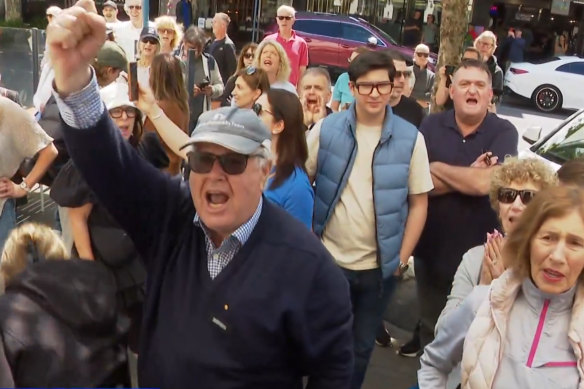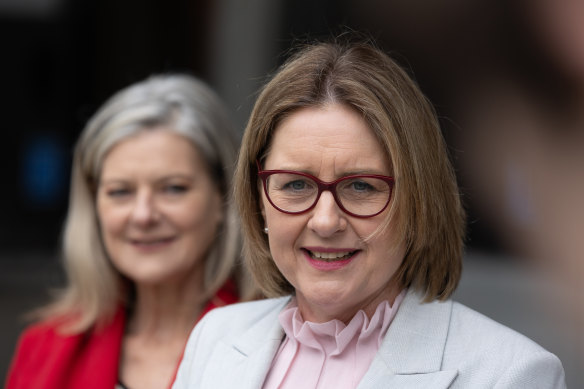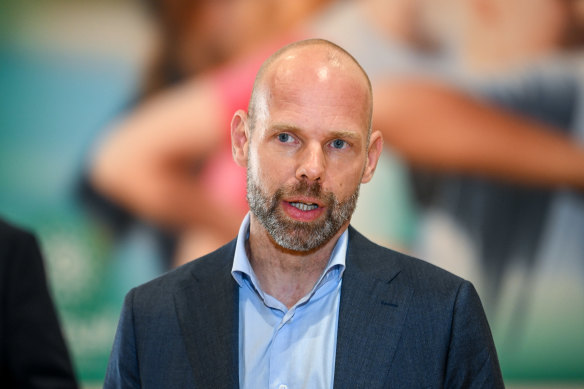This was published 5 months ago
Inside the housing plan that sent Victoria’s political leaders behind enemy lines
By Kieran Rooney and Annika Smethurst
Victoria’s political leaders both made potentially career-defining pitches this week in the heart of enemy territory.
As Jacinta Allan kicked off a week of housing announcements intended to revitalise her government, she spoke directly to Millennials and Gen Z, posting a video on Instagram empathising with those who had just spent their Saturday inspecting homes and losing out.

The protest outside Jacinta Allan’s housing announcement in Brighton.Credit: Nine News
“I know there’s a hell of a lot more to do, and I’m determined to get on with it,” she said.
By Sunday morning, current and former Liberal MPs were leading a crowd of about 100 people outside Brighton’s Half Moon Hotel chanting “shame, premier, shame” as Allan revealed plans for 50 activity centres that would encourage density around railway lines. A large chunk of the first 25 centres are in safe Liberal seats.
The contrast was striking. Opinions vary on whether Allan’s team was intentionally hoping to spark a reaction by making the announcement in Brighton, but the premier seized the opportunity.
As the hostile crowd waited outside, Allan painted them and local MP and Liberal planning spokesman James Newbury as “blockers”. As video of the protest filtered online, progressive keyboard warriors made jokes about entitled Karen from Brighton.

Jacinta Allan and Sonya Kilkenny.Credit: Jason South
Hours after Allan faced that hostile Brighton crowd on Sunday, Opposition Leader John Pesutto was in Moonee Ponds, Labor heartland, addressing hundreds of residents concerned about two activity centres already being planned in their area.
He said the government was leaving people with “no voice and no choice”.
Figures across the political spectrum are split about which gamble will pay off but, as one Labor MP pointed out, both sides agree on one thing.
“At least we’ve got a fight on our hands,” they said.
The first year of Allan’s leadership has been defined by “clearing the decks” of difficult policy hangovers from her predecessor – and watching Labor’s primary vote slump to its lowest point in years.
Her MPs were starting to worry about the government’s direction, but Allan’s team now believes Labor is on a winner that will define her term in power.
By the next election, it’s estimated that Millennials and Gen Z (those born from 1981 to 2012) will account for about 55 per cent of enrolled voters.
Labor is confident its commitment to build medium and high-density housing in established suburbs will appeal to this soon-to-be-dominant voting bloc, who have long been locked out of the housing market due to their smaller borrowing power and rising house prices.
One party source, speaking anonymously to avoid repercussions, said it was overly cynical to think of the policy as just a pitch for young voters. Cost of living is the biggest concern in polling, but housing also scores very highly, is a massive policy issue and is regularly on the minds of parents, migrant communities and anyone buying or renting.
They said the Liberals’ pitch to those opposed to development might produce swings in some seats but was too narrow to build an election-winning coalition.
“If the Liberals play to their base, like they did in the last two elections, they will lose … again,” they said.
Internally, it is hoped the policy will not just dig Labor out of its electoral problems but also its economic woes.
A one-year stamp duty discount on off-the-plan apartments, units and townhouses aims to stimulate the industry at a cost of $55 million to the government’s bottom line.
But the massive rezoning overhaul across the state is also expected to trigger a tax boost on land that is not already zoned residential, with industrial sites within activity centres potentially providing a boon to government coffers.
AMP chief economist Dr Shane Oliver said there was merit in the government’s strategy, but Victoria had been guilty of sending mixed messages to the private sector.
“The stamp duty initiative is good, but a lot of investors are facing massive land tax bills now and selling their rental properties,” he said.
“Unless you do something about that, you probably won’t get enough investors, even though the stamp duty concession is quite attractive.
“Housing is a relatively small part of the economy, but it is often a part of the economy that if you can get going, it can help the rest of the economy.”
For that reason, it’s little surprise the origin of this week’s housing overhaul can be traced back to the offices of Allan and Treasurer Tim Pallas.
Net debt is expected to peak at $187.8 billion by the middle of 2028 – equivalent to about one-quarter of the state economy – but Pallas has vowed to grow Victoria out of sliding deeper into debt.
Rather than outsource the policy to a government department, Allan and Pallas called on their chief troubleshooter.
Jeroen Weimar has been hired by the Department of Premier and Cabinet to lead the government’s housing statement response, showing how central his role has been to Allan’s agenda.

Jeroen Weimar has been hired to lead the government’s housing statement response.Credit: Eddie Jim
Within the Department of Transport and Planning, deputy secretary of strategy and precincts Natalie Reiter has also been a key player in formulation of the policy and interaction with the industry.
Housing Minister Harriet Shing and Precincts Minister Colin Brooks were also part of the policy process, with senior figures impressed by Planning Minister Sonya Kilkenny’s policy nous.
Government sources did not point to a single eureka moment that sparked the housing overhaul. The issue was already identified as central to Labor’s fortunes when former premier Daniel Andrews made the housing statement his last grand policy declaration as leader.
But the statement was criticised as being nothing more than a glossy brochure, light on details. Since assuming the leadership, Allan’s team has slowly been putting meat on the bone.
“Looking back at the housing statement, it set out a challenge and established the parameters of the problem,” YIMBY Melbourne lead organiser Jonathan O’Brien said.
“This is the week that actually looked at addressing this problem.
“We have consistently been making the argument that housing is economic infrastructure. The reality is that housing is inseparable from economic prosperity.”
The timing of this week’s announcements were also critical.
There was nervousness emerging in the Labor ranks about the negative feedback the party was getting from door knocks about the government’s direction, and government MPs had become concerned about a perceived inertia in the premier’s office.
And with the Liberals locked in an internal fight, it was a perfect time for Labor to stage a reset.
The first sign was the attack coming from the premier’s office and ministers, who launched as many public criticisms of the opposition as possible, a defined strategy, one government source said, to restore confidence to worried members of the Labor caucus.
This was then backed by a week of policy announcements – including stamp duty reforms, new greenfield housing sites and a tougher building regulator – that would give MPs something to hang their hats on in talks with their communities.
The decision to hold the activity centre press conference in Brighton was not intended to incite an angry mob. But it did build on a trend of Allan and Kilkenny taking their fight into council areas, such as Boroondara, they argue aren’t pulling their weight in approving more homes.
It’s hoped that the combination of attacks and fresh policy will reset the government’s fortunes.
According to a recent survey, conducted by Resolve Strategic, Labor’s primary vote has stagnated at 27 per cent, a 12-point drop in core support for the government in the past 12 months.
Labor-aligned pollster Kos Samaras believes the housing overhaul offers Allan a chance to define her premiership, and escape from the shadow of Andrews.
Several MPs told The Age that the housing overhaul had given the caucus a renewed sense of direction.
One said while they had not been well briefed on the government’s announcements, there was optimism about having a vision and point of difference from the Coalition.
“We think the Liberals are underestimating the mood of younger voters on this issue,” the MP said.
Another said they backed the strategy of the premier’s office, but were worried about negative feedback until the plan was fleshed out further.
One key cause of concern is the narrative that all 50 new activity centres could allow apartment towers up to 20 storeys. It’s a claim voiced by the Liberals but also repeated in the media.
The lack of certainty around height levels has allowed the idea to fester in communities despite the government disputing towers in these areas will be anywhere near that tall.
Kilkenny branded it Coalition “mischief”, arguing that the only 20-storey tower in the 10 existing activity zones was one in Ringwood, approved before the implementation of the transport hubs.
The government said any suggestion of buildings above 20 storeys was “fearmongering at its finest”.
“Every centre will be treated differently,” Kilkenny said. “What might be a right height and size in one centre may not be the right fit for another.”
Samaras said housing, or lack thereof, was the number one issue for voters born after 1981, and many of their parents who worry their children will not be able to afford their own home.
“Governments that are perceived not to be responding are copping flak,” he said.
While he was confident the housing policy would ultimately be a vote winner, Samaras said it was unlikely to result in an immediate poll bounce.
“It won’t be until people see the proof in the pudding that it will help,” he said.
Samaras said the policy would also help Labor in areas at risk of turning Green at the next election.
So far, the Greens have called on the Allan government to guarantee bigger quotas of public and affordable housing in new developments, while their federal colleagues have been pushing to eliminate negative gearing and the capital gains tax discount.
Samaras said Greens candidates and MPs that strongly opposed the new housing reforms “are going to be hurt”, particularly in seats where they performed well in 2022, such as Pascoe Vale, Preston and Footscray.
Meanwhile, the opposition, which seems to be tempted by the NIMBY vote, remains confident it can unpick Labor’s plan without coming across as anti-development.
Key to that plan, Liberal insiders say, will be to sell the idea that the housing overhaul is doing little to help residents on Melbourne’s suburban fringe who for years have been crying out for greater investment in new roads, transport, schools, hospitals and services.
“There’s still nothing really in it for them,” one Liberal MP said.
Liberal strategists are urging the party room to remind residents in these growth areas that Labor has known about the chronic underinvestment in their suburbs for years and done little about it.
This was also part of the party’s strategy in 2022. However, the mood against the incumbent government is much worse now.
Get the day’s breaking news, entertainment ideas and a long read to enjoy. Sign up to receive our Evening Edition newsletter.